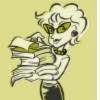 McDonald, Megan. Peter H. Reynolds. (Ill.) 2005. STINK: THE INCREDIBLE SHRINKING KID. Cambridge, MA: Candlewick Press. ISBN 0-7636-2025-4
McDonald, Megan. Peter H. Reynolds. (Ill.) 2005. STINK: THE INCREDIBLE SHRINKING KID. Cambridge, MA: Candlewick Press. ISBN 0-7636-2025-4James “Stink” Moody is a typical second grader. He is responsible, follows rules, loves our country’s 4th president, and likes doing homework. Ok. Maybe he’s not so typical. However, his relationship with his sister is—mostly. Though Stink and his sister Judy fight about things such as how best to care for the class newt, their arguments are more civil than some I’ve seen in real life. This comical story of a bossy big sister and powerless little brother is more easily enjoyed than would be a tale of a more realistic and querulous relationship. Stink and Judy’s sibling rivalry is dictated more by age than gender. McDonald and Reynolds work together to make a book which is appealing to newly independent readers. Through the use of large print, large margins and frequent illustrations this book is appealing to children who are unsure of their ability to tackle novels. In addition, each chapter concludes with a Stink-authored comic strip which is humorously connected to the chapter’s conflict. Though the plot begins slowly, humor fills the gaps until the story’s turning point. While the author’s commitment to the light-heartedness of the story lessens its verisimilitude, the target audience will enjoy Stink’s journey to discovering we all grow in our own time.
This contemporary realistic fiction novel, with its frequent comic-book style illustrations, is recommended for both read-alouds and independent readers in grades K-4.

